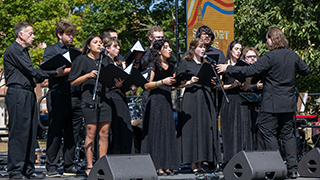Communication Professors’ Essay on Iwo Jima Flag-Raising Photo Featured in TIME
Tuesday, February 25, 2020

Marines Plant Stars and Stripes Atop Mount Suribachi. Attribution: Joe Rosenthal/public domain.
Professors Matthew Pressman and James J. Kimble of the College of Communication and the Arts co-wrote an essay on the iconic Iwo Jima flag-raising photo from World War II.
The essay commemorates the 75th anniversary of what the authors note "is arguably the most famous news photo of all time."
The article, "The Famous Iwo Jima Flag-Raising Photo Captured an Authentic Moment—But Gave Many Americans a False Impression," was also syndicated by TIME magazine and ran in Yahoo News among other media outlets.
The essay notes that "Although accusations that the photo was posed have persisted over the years, those claims are baseless."


Together, Pressman and Kimble looked at the history of the iconic photo of the Iwo Jima flag-raising and what it meant—and didn't—at the time and since.
The authors note that despite modern views to the contrary, the Iwo Jima flag-raising was one of many in the Pacific battleground and that prior to Iwo Jima photos of flag-raisings—symbolic of U.S. military conquest—had been featured in newspapers, magazines, and newsreels with a regularity that made the Iwo Jima raising somewhat commonplace and even "anticipated" by the public.
Unlike the other flag-raisings however, Iwo Jima marked the first on what was at least technically "Japanese soil," and this, the authors note, went a long way toward catapulting the photo into its iconic status. They write,
Although it was 700 miles from Tokyo and its small civilian population had been evacuated earlier in the war, the rocky island was administered as part of the Tokyo prefecture. This circumstance encouraged the press to say that the assault on Iwo Jima represented the beginning of the "battle of Japan"—the final battle of the war in the Pacific, the name implied.
All of these factors contributed to the rapturous reception that greeted Rosenthal's photograph—the first flag-raising, as far as the home front was concerned, on Japanese soil. No wonder, then, that the photo appeared so widely and so prominently. It was hailed by military leaders and members of Congress. The Treasury Department quickly adapted the image to serve as the symbol for a massive war-bond campaign. The final victory over Japan must have seemed to be closer than ever.
The problem with that, however, say the authors, was that the triumphant image raised expectations among many to a point that wasn't entirely in line with the trudging reality of the war in the Pacific theater.
It is in this sense that the authors suggest that the "imminent victory" narrative inspired by the iconic photo was, in some ways, misleading to the American public. In fact, they note that the U.S. government ultimately "walked back" that narrative in a number of ways as the war dragged on contrary to popular expectations.
Pressman and Kimble write,
However, the Battle of Iwo Jima itself was not even over. It raged on for another month after the flag-raising, through late March, and three of the men in Rosenthal's photo died in the fighting (as did the Marine who shot the video of the flag-raising). Then came the dispiriting Battle of Okinawa, which lasted nearly three months and was one of the bloodiest of the Pacific war—and all of that was just a prelude to the anticipated invasion of Japan's main home islands, which promised to be far longer and deadlier.
The home front's hopeful expectations, raised so triumphantly (but also misleadingly) by the Iwo Jima photo, began to plummet in the face of the grinding continuation of warfare.
U.S. officials soon realized they needed to tamp down expectations of an imminent victory. In May 1945, the Treasury Department released a propaganda film, My Japan, in which an announcer with a faux Japanese accent taunted Americans, saying that Iwo Jima was simply a minor "island outpost" and boasting, "You have not yet faced the best of our armies. You have faced only 10% of our worst. Our first-line fighters, millions of them, wait for you on battlegrounds of our own choosing."
The Treasury gave its war bond salespeople a similar script. It suggested they say Iwo Jima was merely "an outpost," and that "as far as Japan is concerned, the outer Empire—and the men who defend it—are expendables."
Of course, the planned invasion of the "inner Empire" (the Japanese homeland) never happened, because Japan surrendered after the U.S. attacked Hiroshima and Nagasaki with atomic bombs in early August. Although subsequent generations have questioned the necessity and morality of those bombings, the American public at the time overwhelmingly supported the decision—85% approved and 10% disapproved, according to a Gallup poll.
It's impossible to know whether Rosenthal's Iwo Jima photo contributed to that public support for the A-bomb. But after seeing that picture, some Americans surely believed that victory was imminent, and they must have been deeply disillusioned when they realized it wasn't so—and thus perhaps more likely to support any measure that might render unnecessary a full-scale invasion of Japan.
Over the last 75 years, the photo's stature has continued to grow. But it has also become decontextualized. It has morphed into an all-purpose symbol of American military heroism, losing its original association with an overly optimistic narrative about the end of the war in the Pacific. And maybe that is as it should be—the photo does accurately convey the bravery and sense of purpose of the flag-raisers.
Categories: Education, Nation and World






